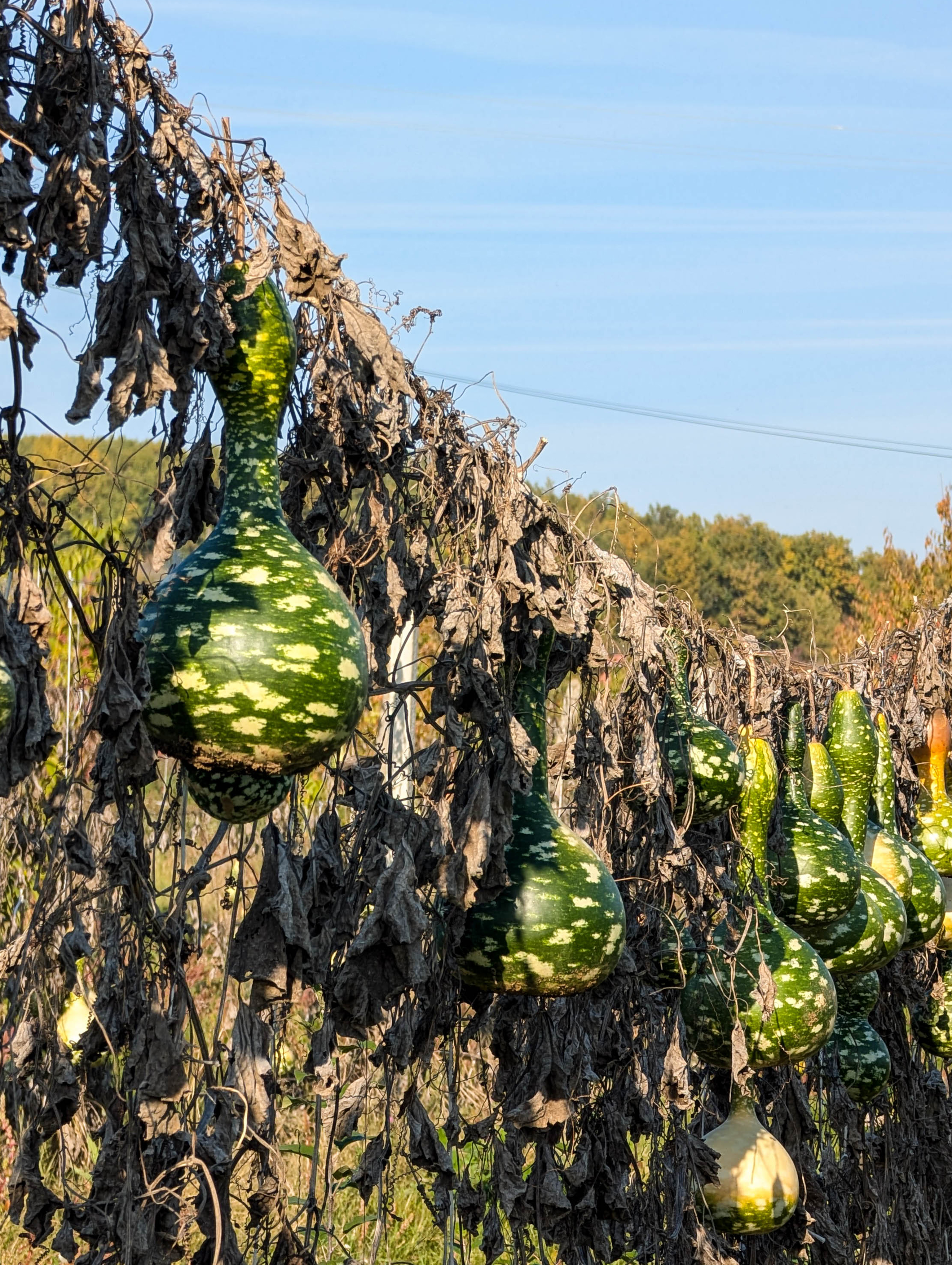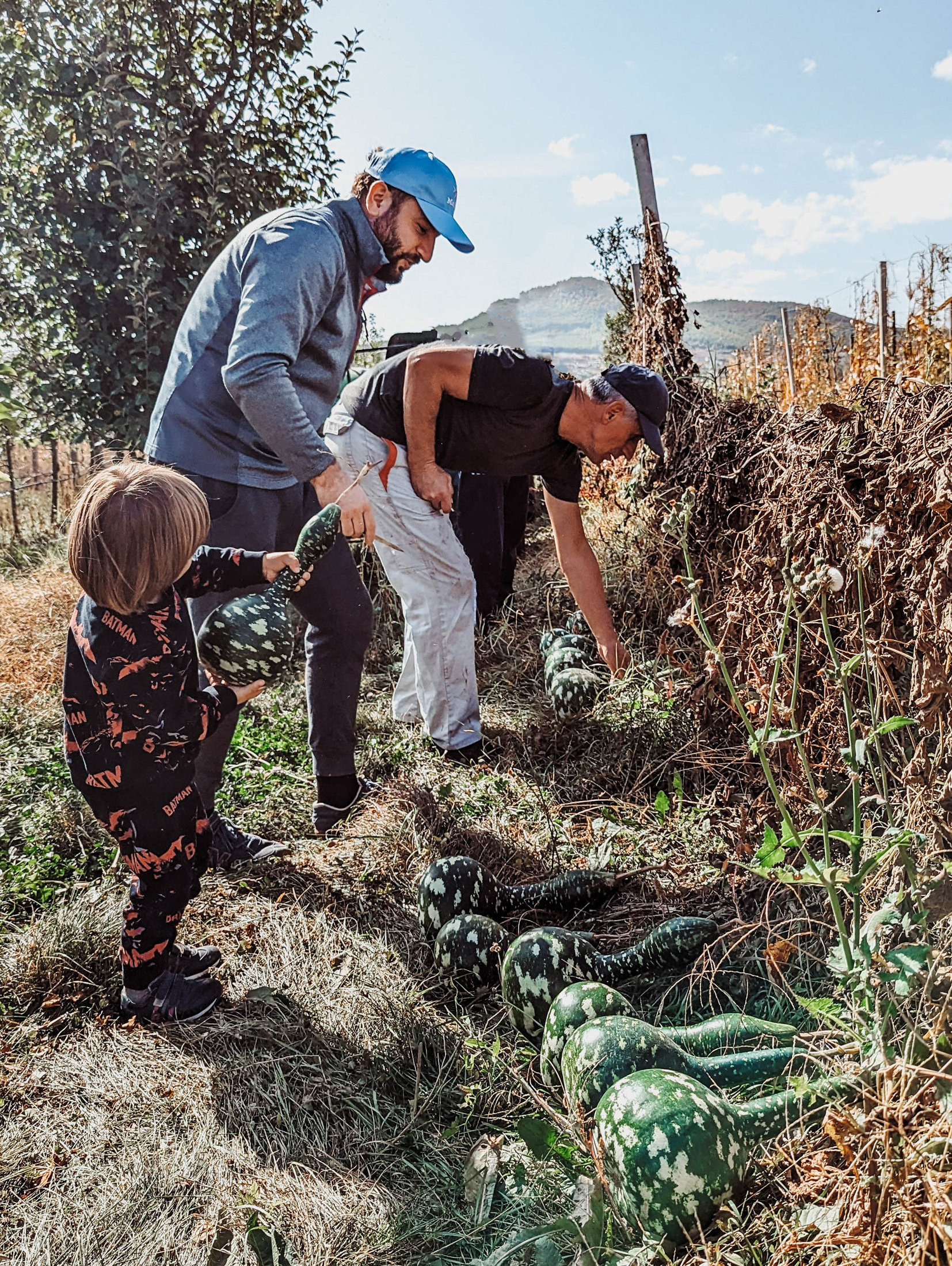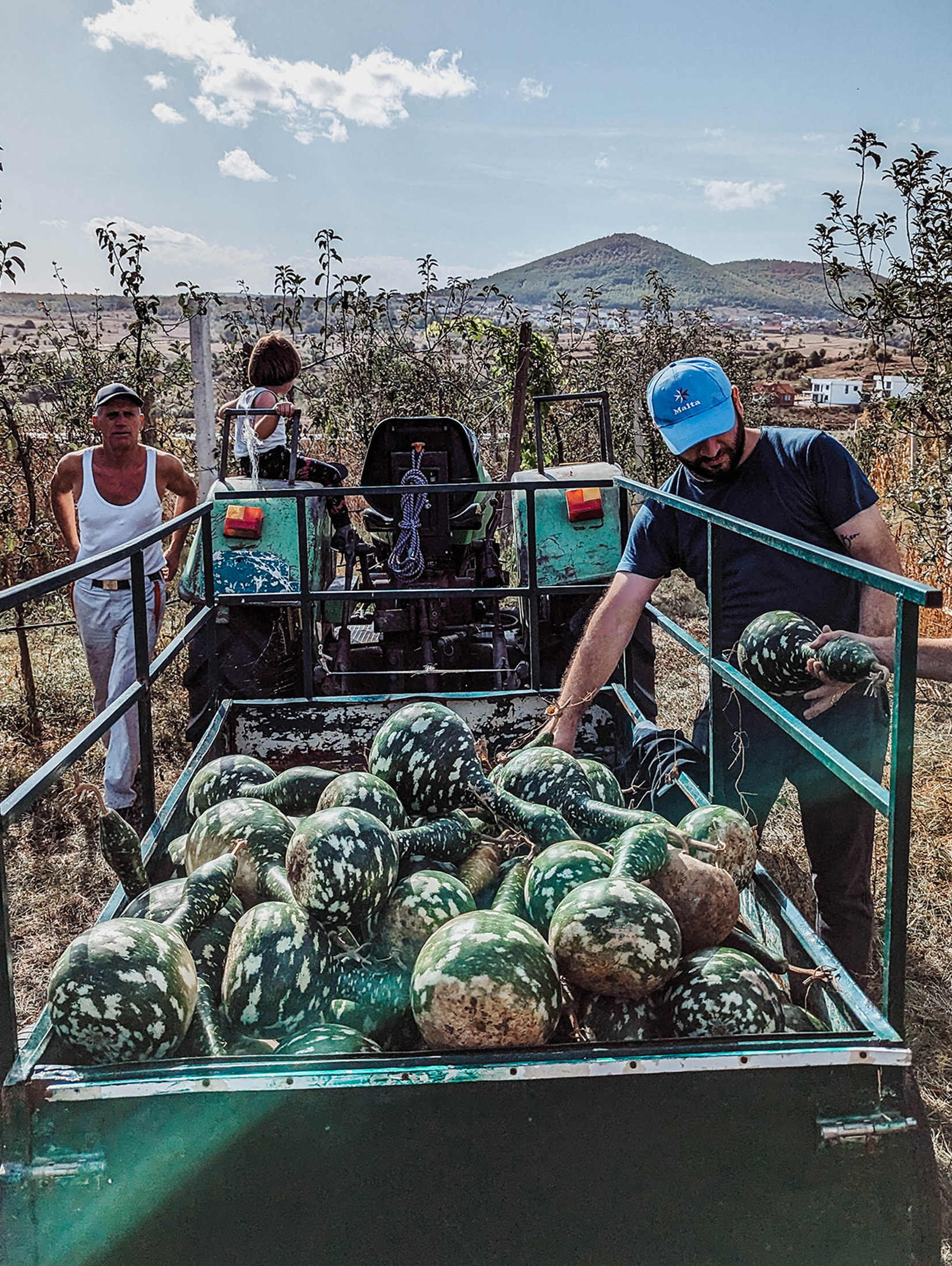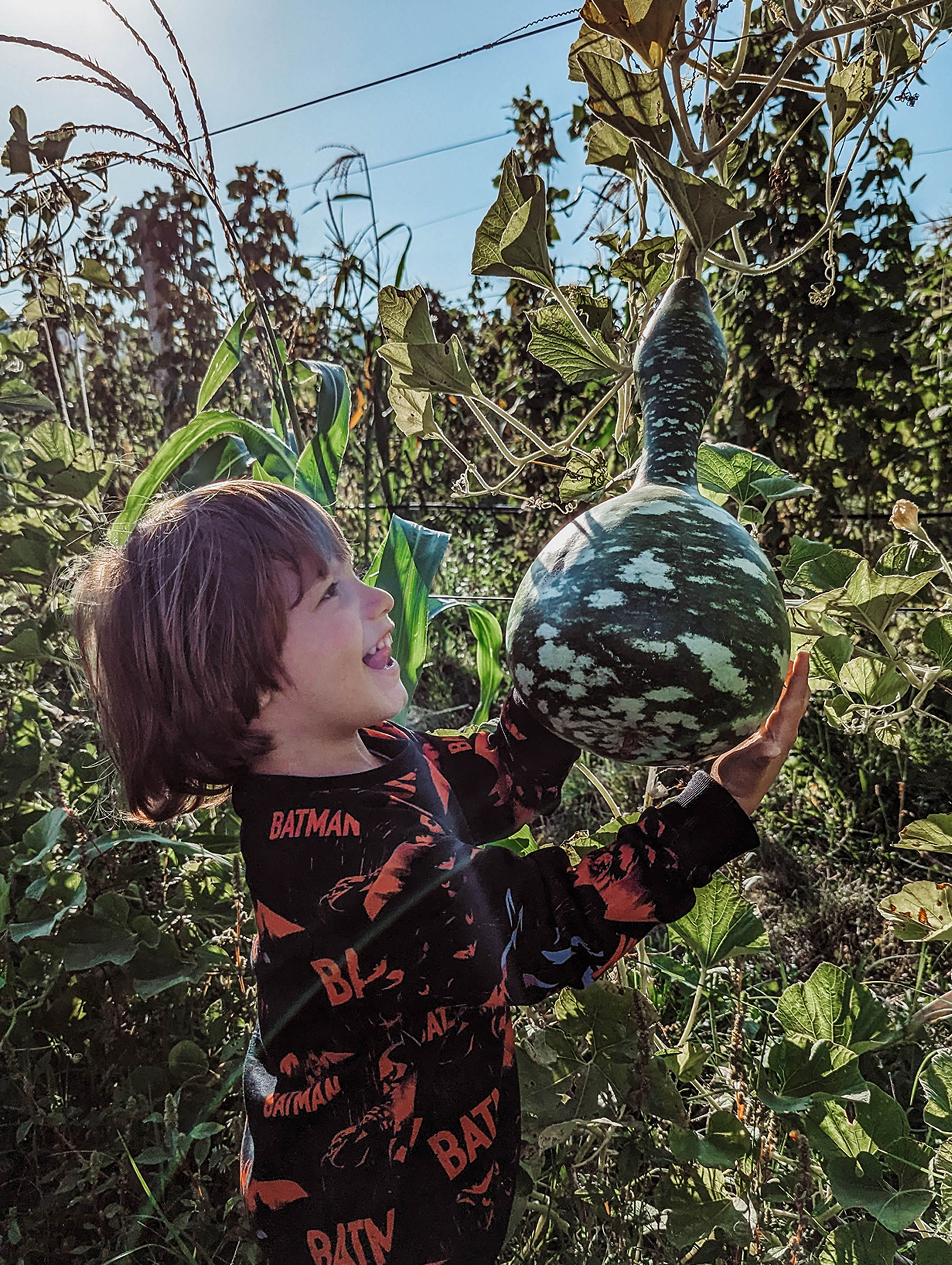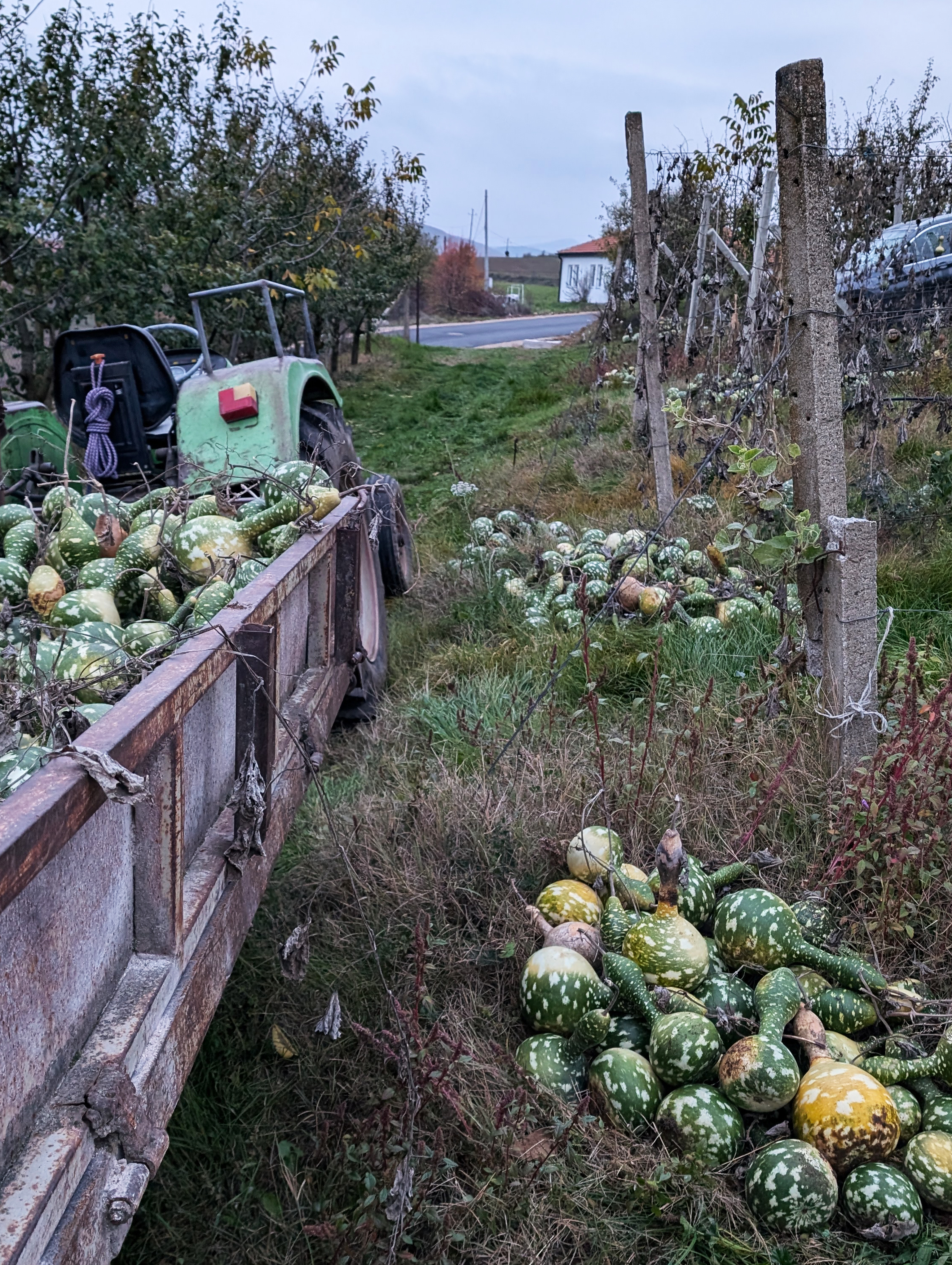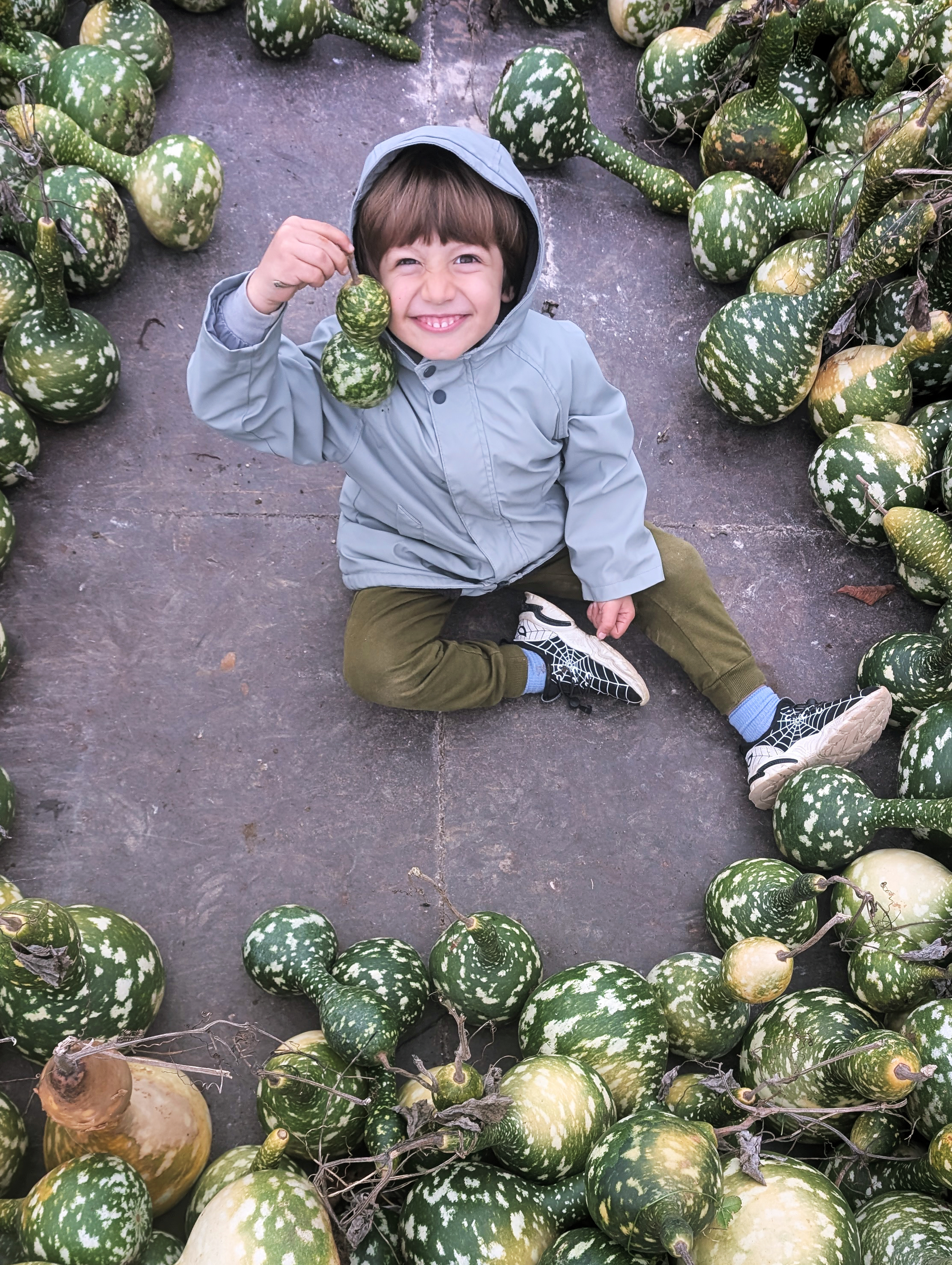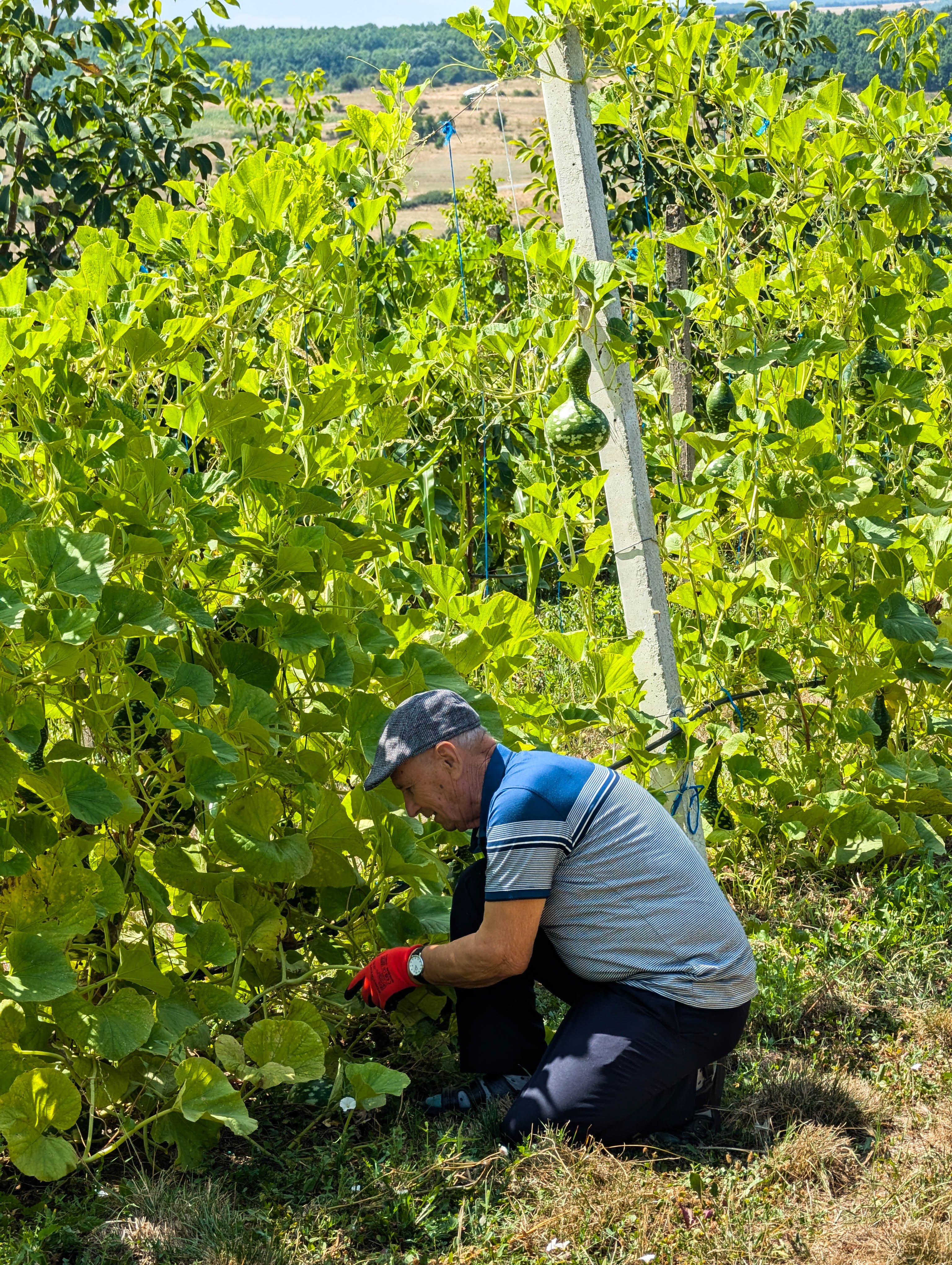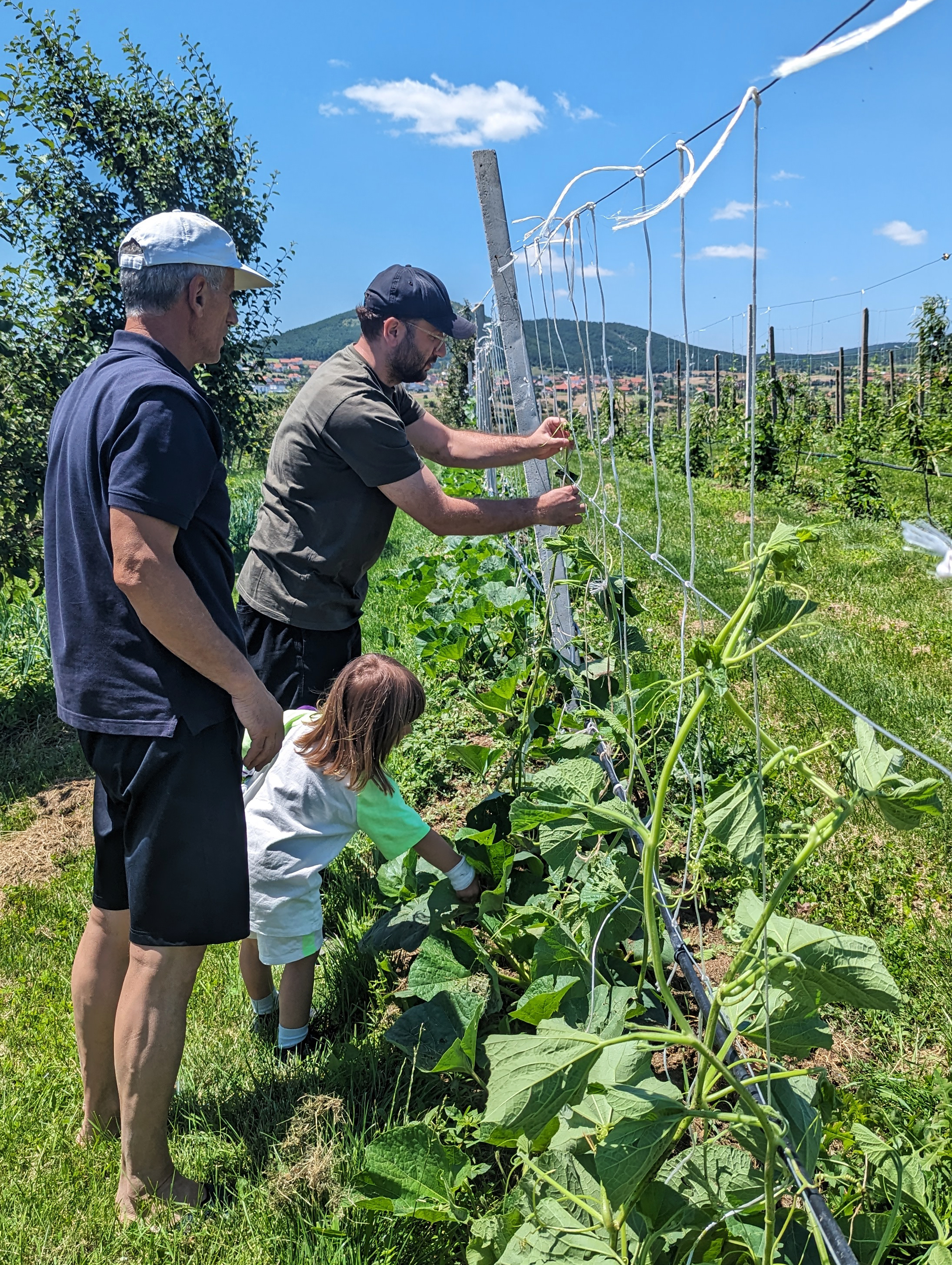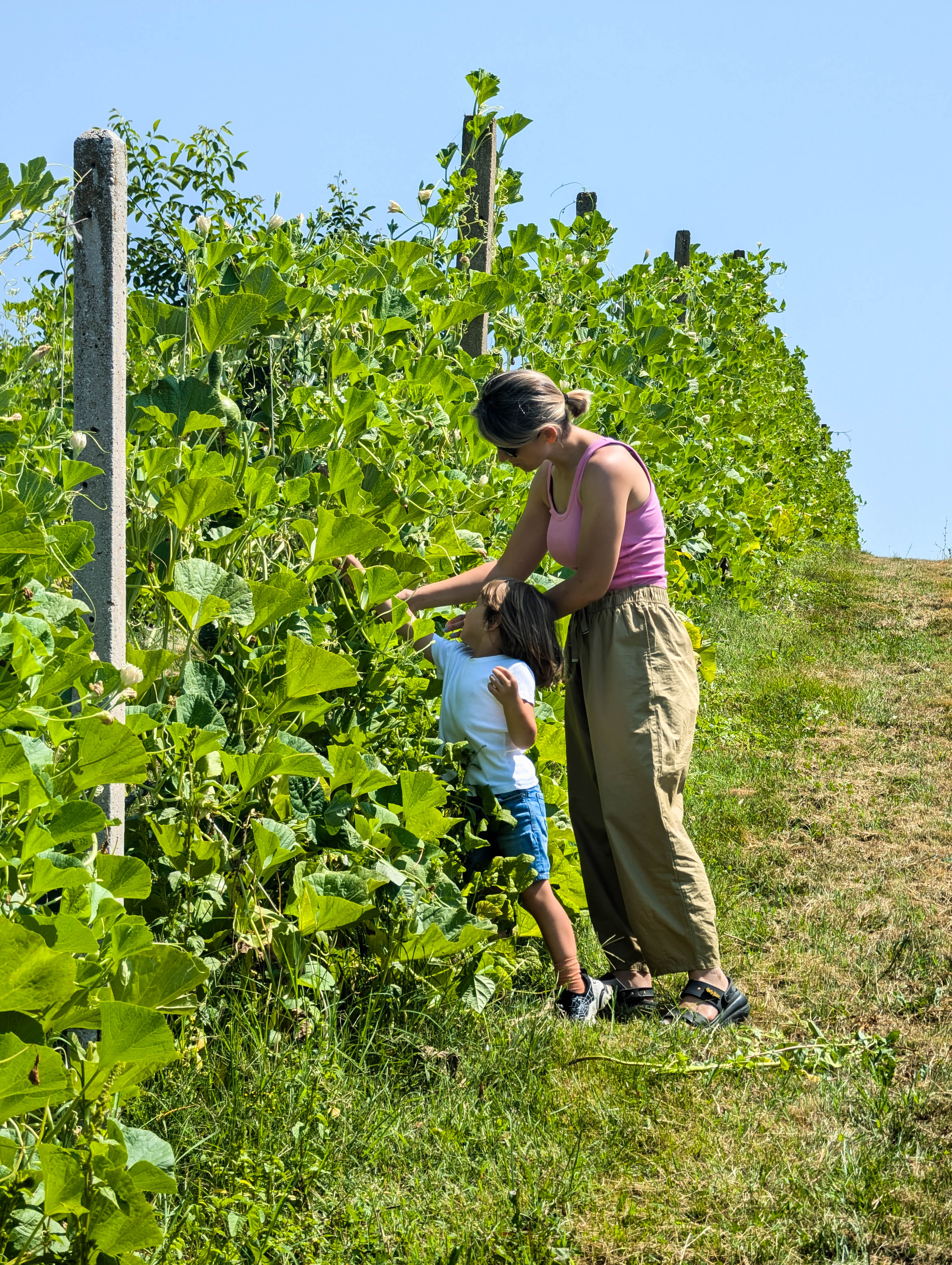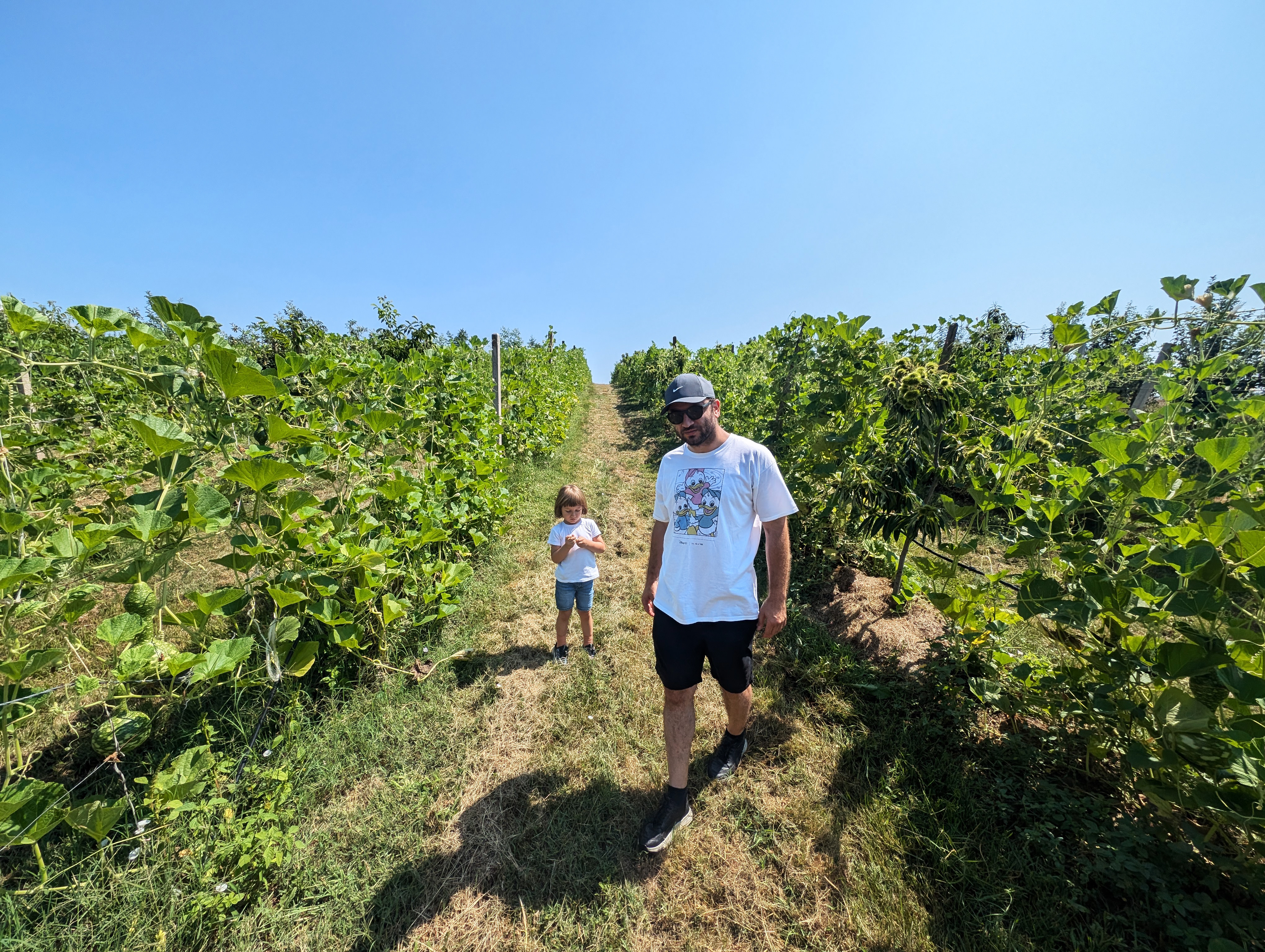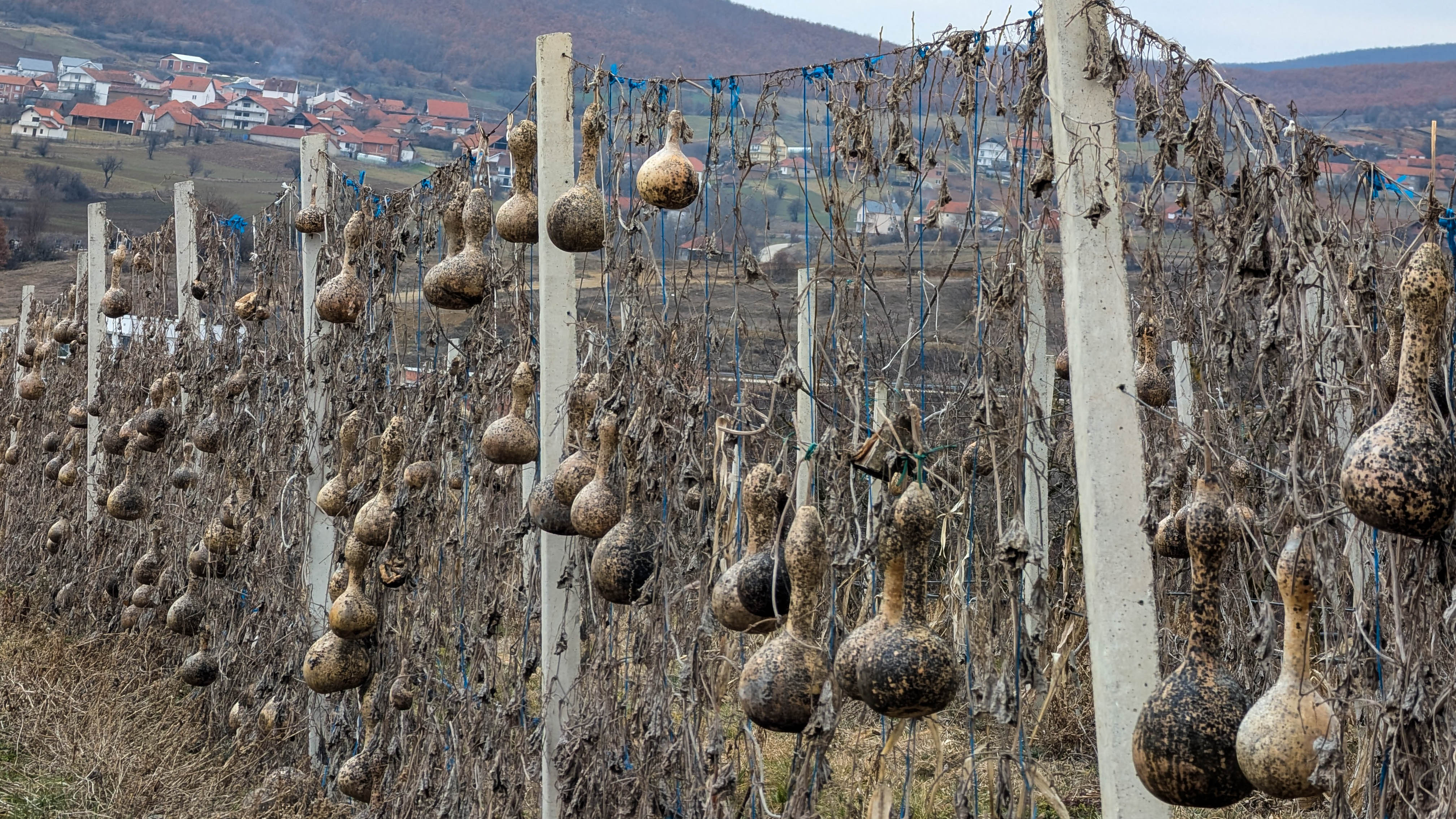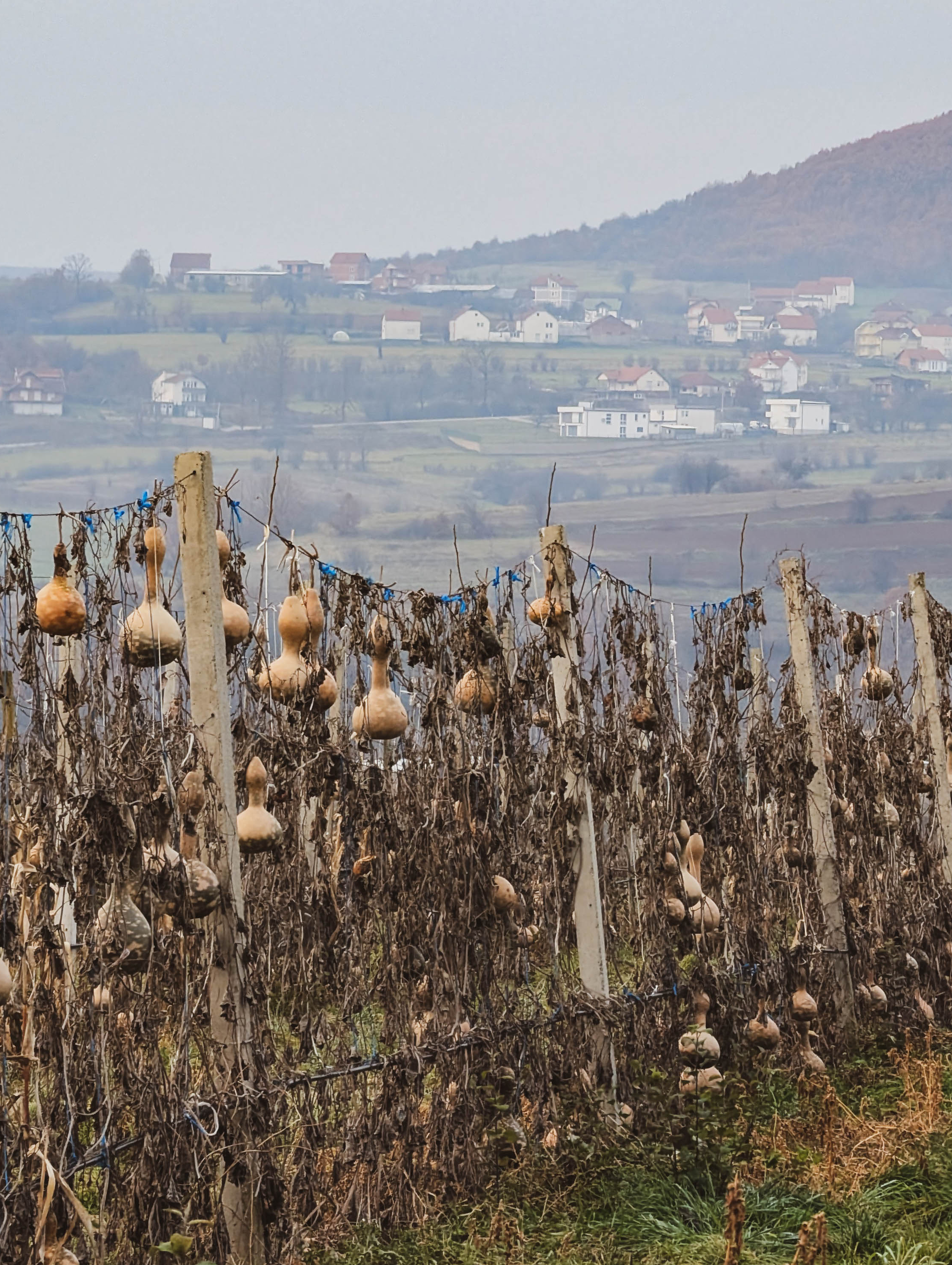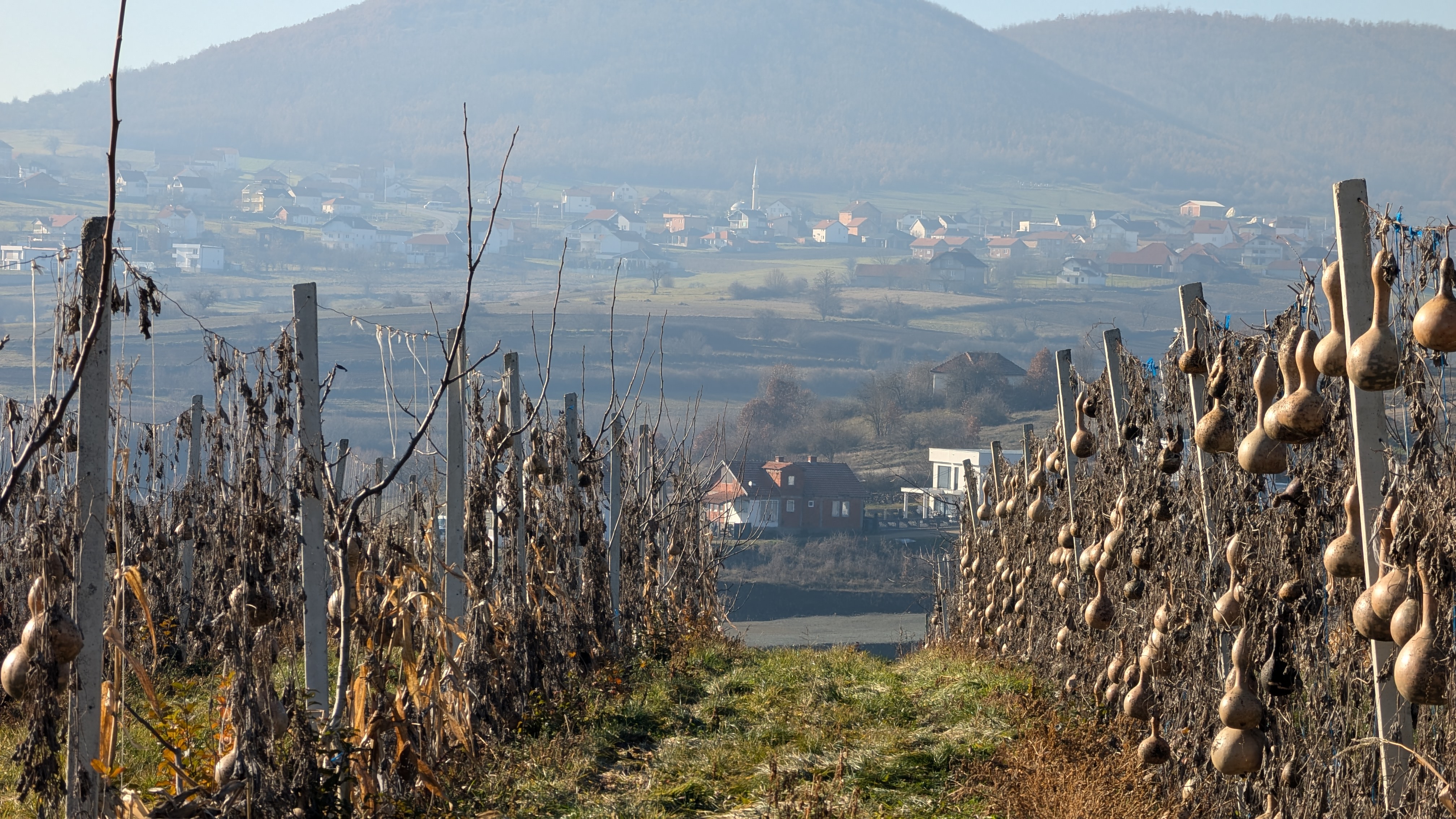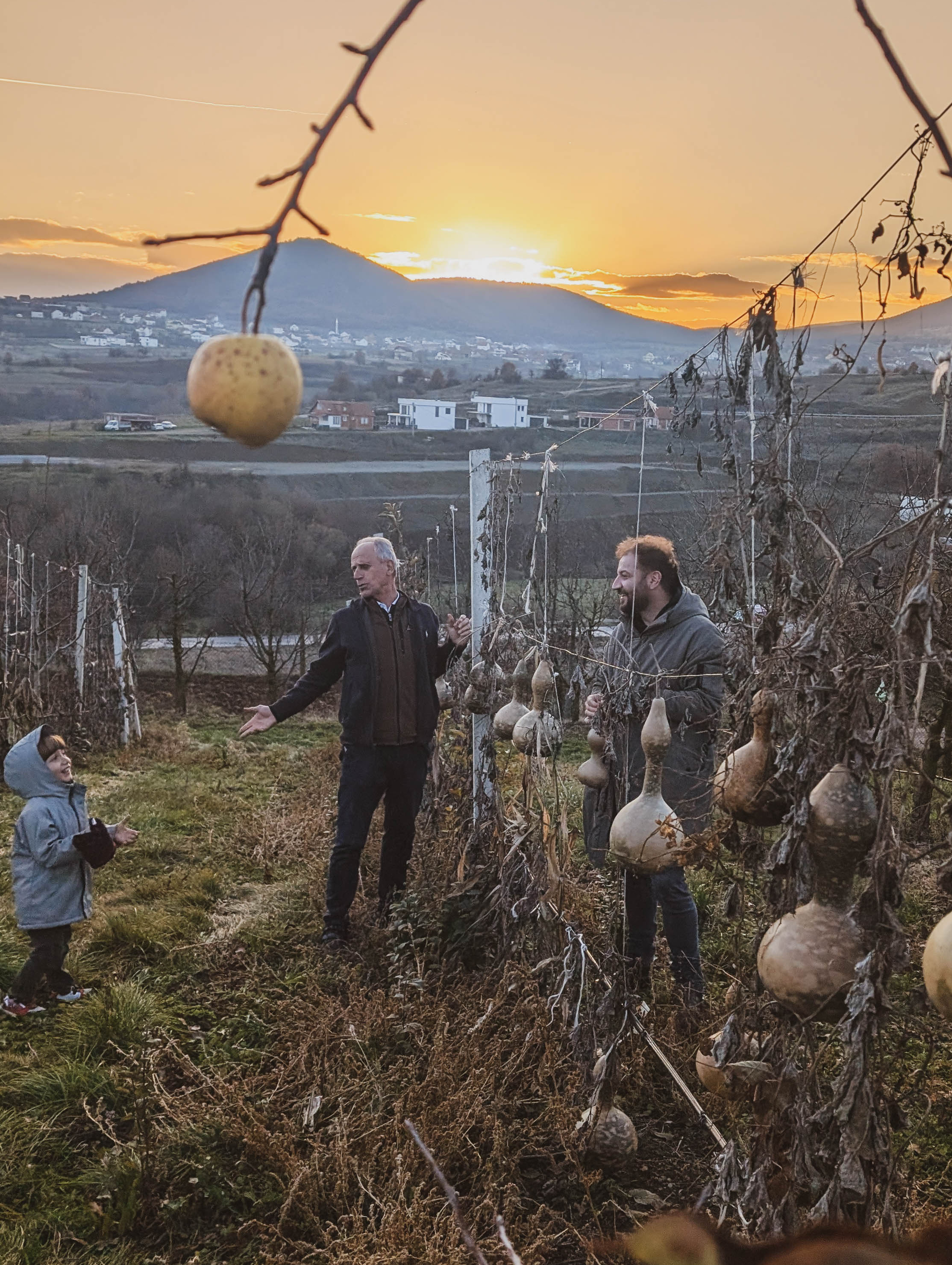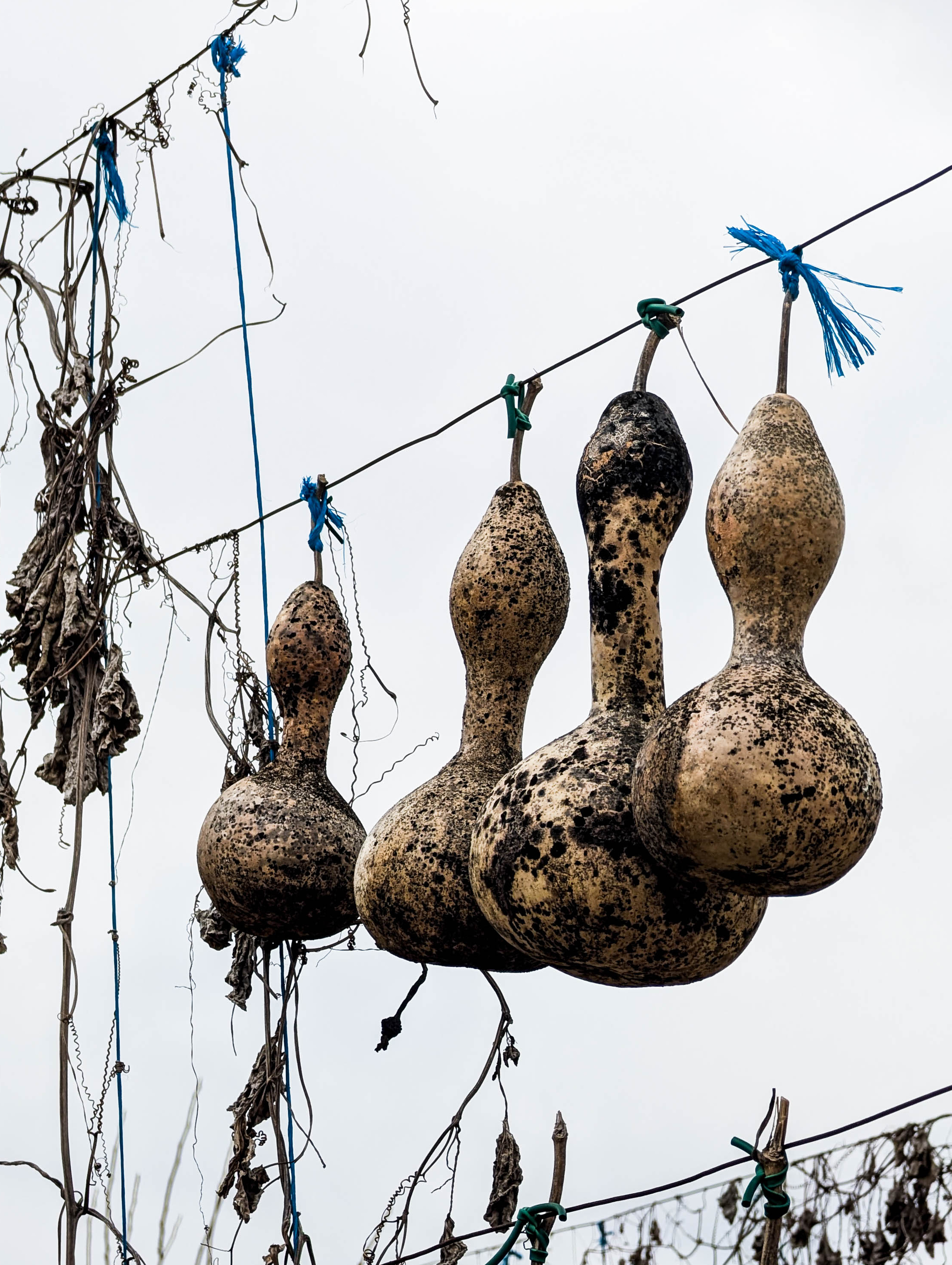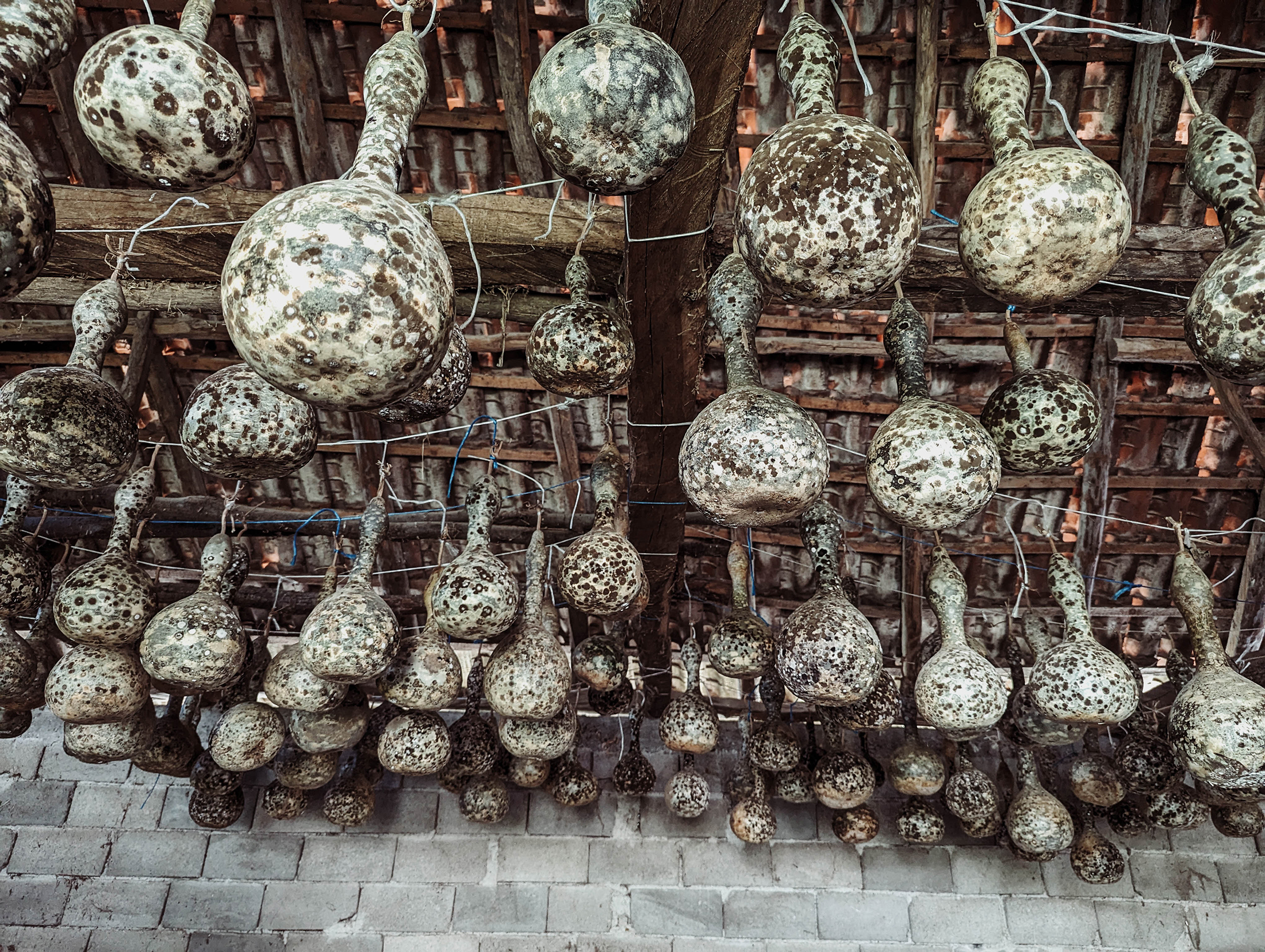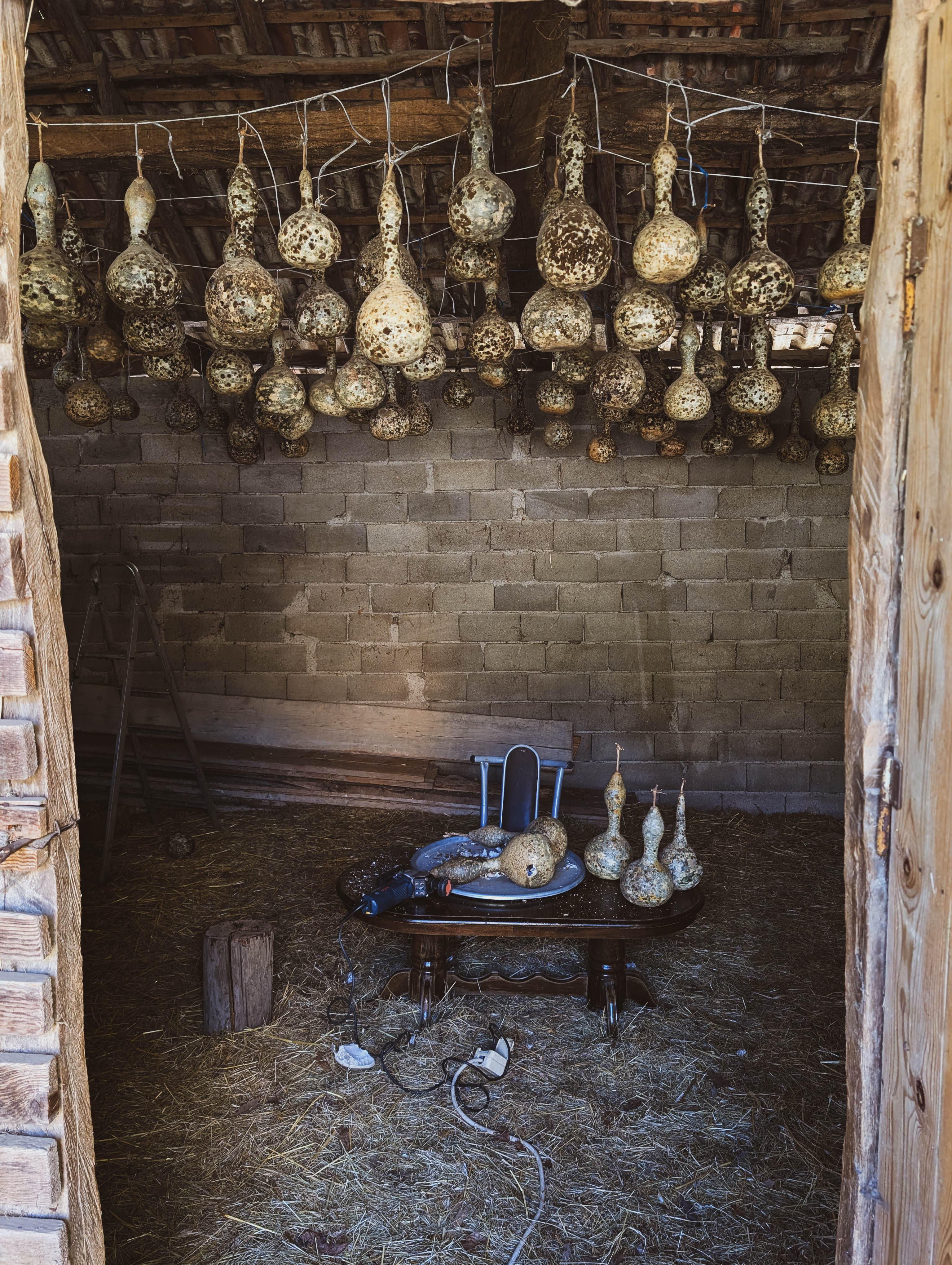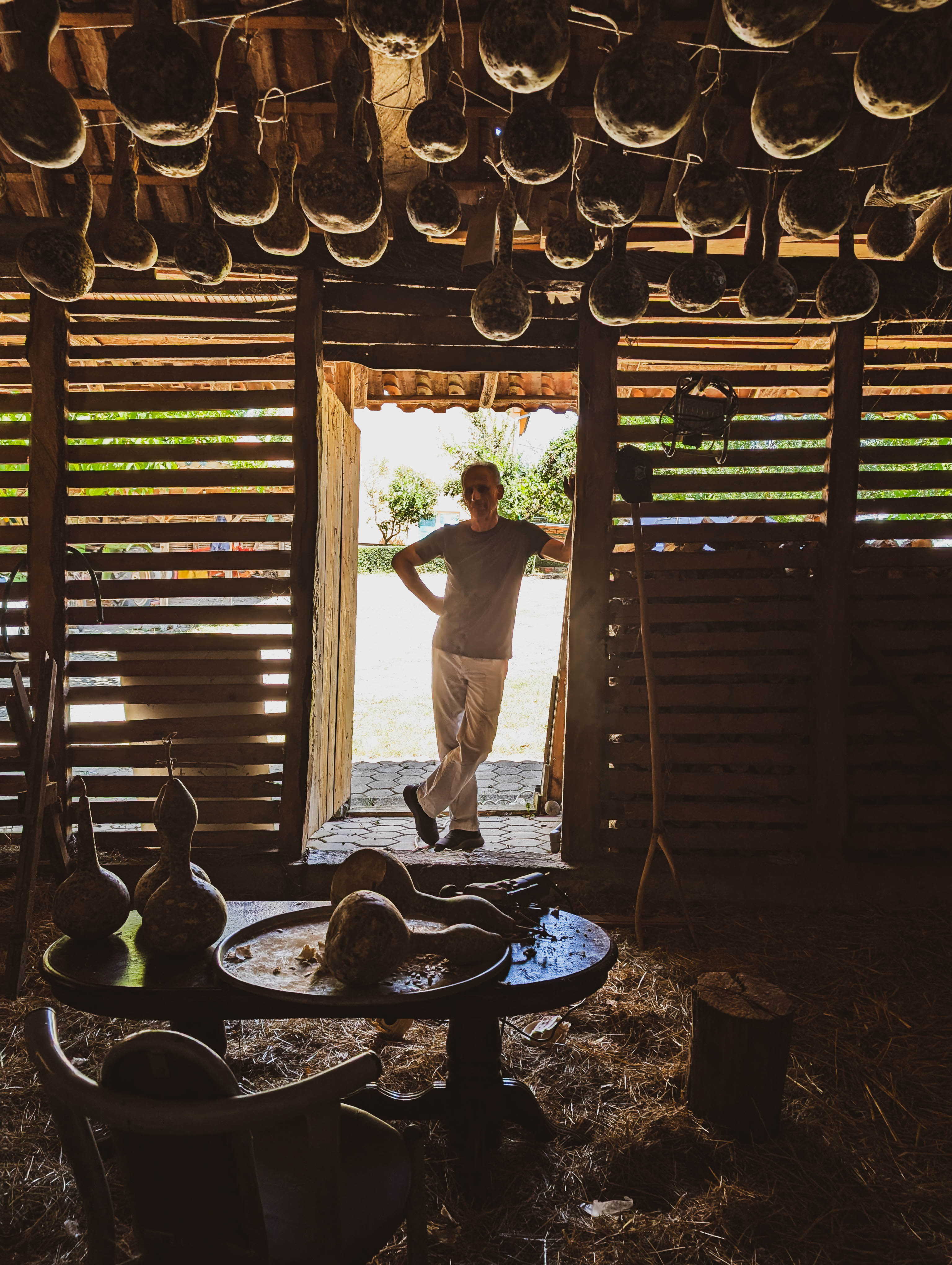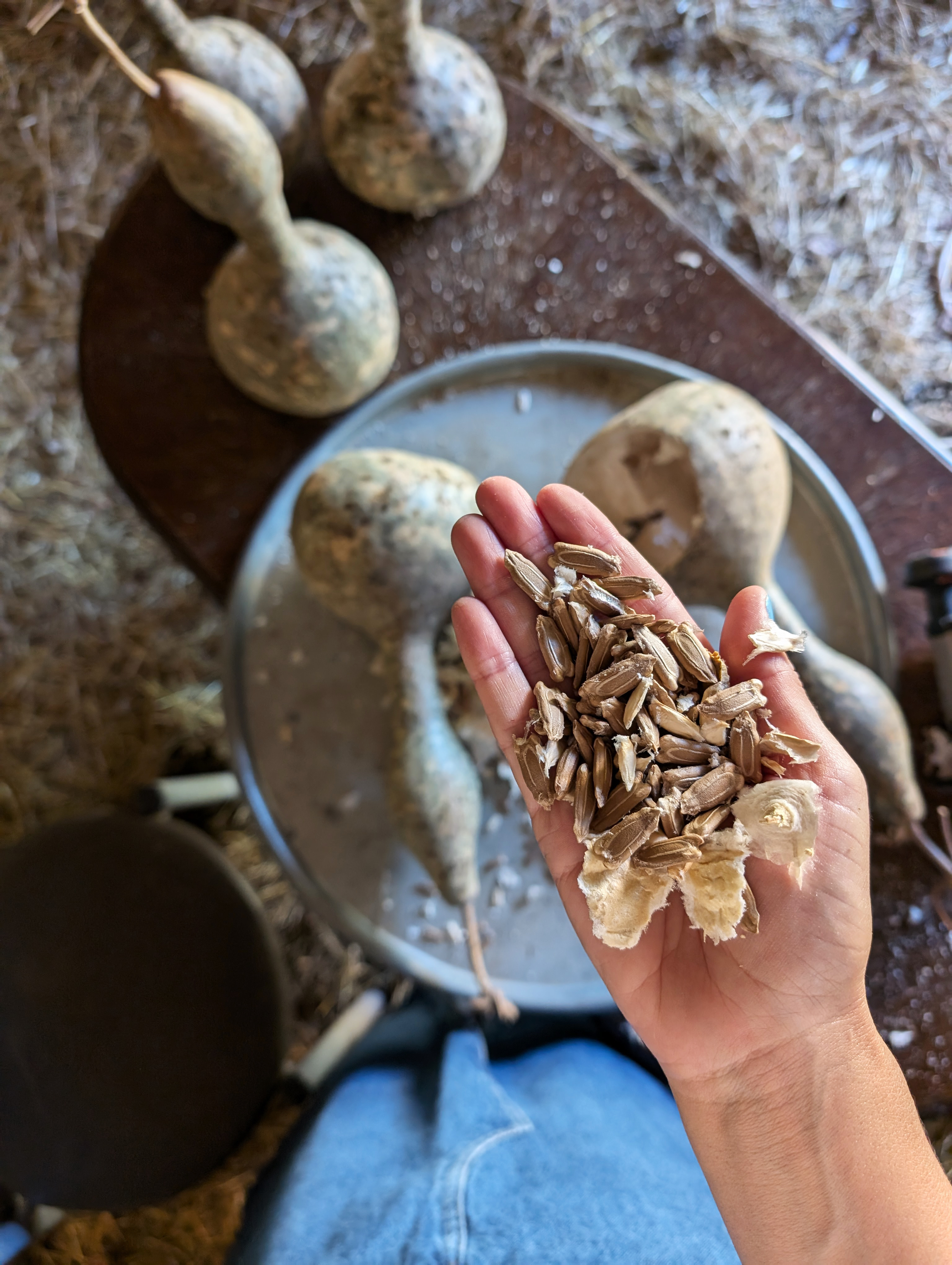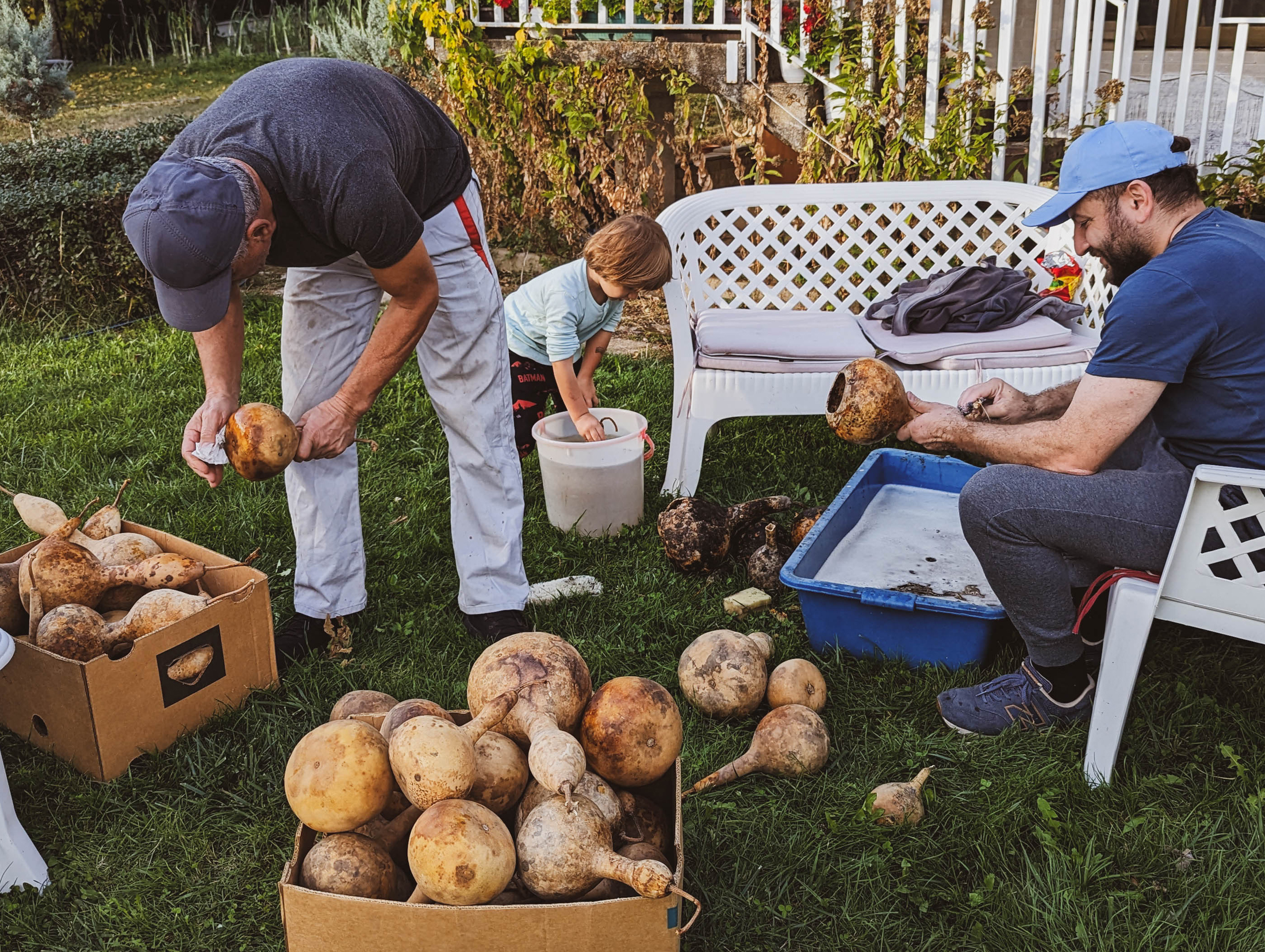Shaping a circular industrial ecosystem and supporting life-cycle thinking
Leka Lighting
Leka Lighting – A Traditional Seed Growing into a Lamp
This eco-project was born from a desire to merge tradition with design. On one hectare of land, we plant and grow gourds - or, as we call them in Albanian, Leka - which have deep significance in our culture. Once used for showers, they hold a special place in our heritage. By reusing these gourds, we give them new meaning and purpose. Grown with care and with my family's help, these gourds go through a year-long process of planting, nurturing, and drying before being transformed into lamps.
Kosovo
Local
Bresalc, Gjilan, Kosovo
It addresses urban-rural linkages
It refers to other types of transformations (soft investment)
Yes
2024-06-15
No
No
No
As an individual
This project was created from my desire to blend tradition with design in a way that is both sustainable and meaningful. In Kosovo, gourds, known as Leka - have long been a part of our culture, once used for everyday purposes like carrying water and mostly for showers. By bringing them back into use in a new way, it gives them renewed purpose while honoring their history. On one hectare of land, my family and I grow and nurture these gourds throughout a year-long process. After being carefully dried, each one is transformed into a unique, handcrafted lamp, bringing warmth and character to any space.
The goal of this project is to create a sustainable, meaningful design that reconnects people with nature and tradition. It offers an alternative to mass-produced lighting by using organic materials, reducing waste, and embracing circular design. Leka Lighting is designed for people who value sustainability, heritage, and artistic expression in their homes and workspaces.
This project reflects the core values of the New European Bauhaus. It is built on sustainability by using 100% natural materials, minimizing environmental impact, and promoting biodegradable design. It also celebrates aesthetics by transforming a simple natural form into a functional, artistic object that enhances modern living spaces with its organic beauty and warm colors. Leka Lighting addresses challenges faced in Kosovo, where crafts are slowly fading, and environmental awareness is still developing. By reconnecting rural cultivation with urban living, the project helps preserve heritage while creating economic opportunities. At the same time, it introduces a new perspective on how nature and design coexist harmoniously. By blending tradition, creativity, and responsible design, Leka Lighting proves that nature itself can be an inspiration for a better, more conscious way of living.
The goal of this project is to create a sustainable, meaningful design that reconnects people with nature and tradition. It offers an alternative to mass-produced lighting by using organic materials, reducing waste, and embracing circular design. Leka Lighting is designed for people who value sustainability, heritage, and artistic expression in their homes and workspaces.
This project reflects the core values of the New European Bauhaus. It is built on sustainability by using 100% natural materials, minimizing environmental impact, and promoting biodegradable design. It also celebrates aesthetics by transforming a simple natural form into a functional, artistic object that enhances modern living spaces with its organic beauty and warm colors. Leka Lighting addresses challenges faced in Kosovo, where crafts are slowly fading, and environmental awareness is still developing. By reconnecting rural cultivation with urban living, the project helps preserve heritage while creating economic opportunities. At the same time, it introduces a new perspective on how nature and design coexist harmoniously. By blending tradition, creativity, and responsible design, Leka Lighting proves that nature itself can be an inspiration for a better, more conscious way of living.
Sustainability
Tradition
Design
Craftsmanship
Innovation
Leka Lighting blends sustainability and tradition by transforming naturally grown gourds into handcrafted lamps. Known as Leka in Albanian, these gourds have deep cultural roots, and this project gives them a new purpose while respecting nature. Cultivated on one hectare of land without industrial manufacturing, the process is environmentally responsible, reducing carbon emissions and promoting a thoughtful approach to design.
The project follows circular economy principles, using natural, non-toxic finishes and a drying process that requires no artificial energy. The lamps are durable, minimizing waste and the need for frequent replacements. This initiative demonstrates how natural materials can be repurposed into functional, modern designs. It promotes ethical production on a small scale while encouraging a deeper connection between people and the environment. By reintroducing tradition into contemporary spaces, Leka Lighting proves that sustainability can be both practical and beautiful, offering a model that can be adapted and expanded in the future.
The project follows circular economy principles, using natural, non-toxic finishes and a drying process that requires no artificial energy. The lamps are durable, minimizing waste and the need for frequent replacements. This initiative demonstrates how natural materials can be repurposed into functional, modern designs. It promotes ethical production on a small scale while encouraging a deeper connection between people and the environment. By reintroducing tradition into contemporary spaces, Leka Lighting proves that sustainability can be both practical and beautiful, offering a model that can be adapted and expanded in the future.
This is a story of family, tradition, and connection to the land. It all began in Bresalc, a village where my father, passionate about nature, built a plantation on one hectare of land in 2010. His goal was to grow fruits and vegetables for our family, creating a space where we could gather, plant, and harvest together. After the war ended in 1999, we moved to Pristina for better living conditions, but my father never fully left the village. Every weekend, he worked tirelessly in the orchard, turning it into a place of joy, hard work, and togetherness. Over the years, this land became more than just a plantation, it became a symbol of resilience, dedication, and love for nature. Now, this same land is where this project takes shape for the third year in a row. Inspired by the deep history of gourds in our culture, we are transforming them into lighting pieces that blend tradition with modern design. This gourd, once used for carrying water and showers, is a special element in our heritage. Instead of letting this tradition fade, we are giving them a renewed purpose, making each lamp a meaningful object with a past, a present, and a future.
The aesthetics of Leka Lighting come naturally from the organic shapes of the gourds, ensuring that every lamp is unique. Their textured surfaces, warm tones create a sensory experience that brings character and authenticity to any space. Unlike mass-produced lighting, each piece carries the marks of nature and craftsmanship, making it personal and full of life. Quality of experience is at the heart of this project. It is not just about making lamps, it is about preserving a way of life, reconnecting people with nature, and valuing the beauty of handmade objects. The process from seed to light takes over a year, requiring patience, care, and respect for nature’s pace. My father, who still takes care of the land, continues to be an inspiration, reminding me that the best things in life take time and dedication.
The aesthetics of Leka Lighting come naturally from the organic shapes of the gourds, ensuring that every lamp is unique. Their textured surfaces, warm tones create a sensory experience that brings character and authenticity to any space. Unlike mass-produced lighting, each piece carries the marks of nature and craftsmanship, making it personal and full of life. Quality of experience is at the heart of this project. It is not just about making lamps, it is about preserving a way of life, reconnecting people with nature, and valuing the beauty of handmade objects. The process from seed to light takes over a year, requiring patience, care, and respect for nature’s pace. My father, who still takes care of the land, continues to be an inspiration, reminding me that the best things in life take time and dedication.
Leka Lighting is an inclusive project that connects people through design, sustainability, and cultural heritage. It is not just about creating lamps but about involving family, friends, and the local community in a meaningful process. From the early stages of planting to the final transformation, this project has been a shared experience where everyone, regardless of age or background, can take part.
The project also focuses on affordability, ensuring that sustainable design is not just for a select few. With prices ranging from €45 to €100, Leka Lighting remains accessible to different groups, making handcrafted, eco-friendly lighting an option for more people.
Beyond the local level, Leka Lighting has also inspired a wider audience by promoting traditional craftsmanship and sustainable living. The project’s story has sparked conversations about cultural identity and responsible consumption, encouraging people to rethink the way they interact with objects in their daily lives.
By blending tradition, sustainability, and accessibility, Leka Lighting serves as an example of how design can be both inclusive and impactful, bringing together people from different backgrounds while preserving a meaningful piece of cultural heritage.
The project also focuses on affordability, ensuring that sustainable design is not just for a select few. With prices ranging from €45 to €100, Leka Lighting remains accessible to different groups, making handcrafted, eco-friendly lighting an option for more people.
Beyond the local level, Leka Lighting has also inspired a wider audience by promoting traditional craftsmanship and sustainable living. The project’s story has sparked conversations about cultural identity and responsible consumption, encouraging people to rethink the way they interact with objects in their daily lives.
By blending tradition, sustainability, and accessibility, Leka Lighting serves as an example of how design can be both inclusive and impactful, bringing together people from different backgrounds while preserving a meaningful piece of cultural heritage.
It is a shared experience that brings together family, friends, and the local community. What started as a small idea three years ago has grown into a meaningful process where different people contribute in their own way. Over time, this land has become a gathering place where family and friends join in to plant, harvest, and transform these natural materials. After planting, the gourds take six to seven months to grow and six to seven more months to dry, a full year of learning, making mistakes, and improving. It is a journey of joy, reconnecting with nature, and creating a new way of living aesthetically while preserving tradition, nature, and sustainability.This project has also shaped me as a designer, allowing me to embrace a new lifestyle, be more present in nature, and stay deeply connected to my homeland. It brings nostalgia, reminding me of childhood memories, while also encouraging hands-on involvement. My husband and five-year-old son have also become engaged in the process, with my son growing curious about cultivating gourds. My mother, sisters, uncle, and cousins have taken part, making it a shared environmental experience. It is a place where anyone can connect with nature, work with their hands, and reconnect with family. Beyond those directly involved, the project has sparked curiosity and conversation within the community. People who interact with Leka Lighting, whether by learning about the process or purchasing a lamp, become part of the story. The project encourages a shift in perspective, showing that objects can have history, identity, and purpose beyond their function. It serves as an example of how design can merge elements that are environmentally responsible and deeply personal, inspiring a wider audience to rethink how they interact with everyday objects.
Leka Lighting has grown with the support of family, friends, and the wider community. My husband has played a key role, working alongside my father in the fields and supporting me financially in bringing this idea to life. With the help of family and friends, we plant, harvest, and prepare the gourds, making it a shared effort filled with care and dedication. The project has also gained recognition beyond our family. Locally, it has sparked interest among design enthusiasts, media, businesses, and sustainability-conscious individuals. Some stores and design spaces have shown interest in showcasing the lamps, and media coverage has helped raise awareness. I have held two exhibitions featuring Leka Lamps, one in November at Kult Plus Gallery, a well-known cultural space in Kosovo, which had a big local impact, and another at the Stockholm Furniture Fair 2025 from February 4-8, where I presented the Leka project to a wider audience, gaining valuable networking opportunities at a European level. Additionally, I was featured by the Associated Press agency, further expanding the reach of the project.
In Kosovo, the project has been well received by media, artists, and designers, who see it as an important step toward fostering a more conscious mindset, both in terms of cultural appreciation and eco-design. It has sparked discussions on how tradition can be reimagined in a sustainable way, encouraging a shift towards responsible consumption and the use of natural materials in contemporary design.
Applying for competitions like the New European Bauhaus Prizes can connect Leka Lighting to a broader network of designers, new opportunities, media, and sustainability advocates. This exposure could open doors to collaborations, funding opportunities, and international buyers, proving that this idea has a universal appeal beyond Kosovo. It could also have a significant impact on my growth as a designer.
In Kosovo, the project has been well received by media, artists, and designers, who see it as an important step toward fostering a more conscious mindset, both in terms of cultural appreciation and eco-design. It has sparked discussions on how tradition can be reimagined in a sustainable way, encouraging a shift towards responsible consumption and the use of natural materials in contemporary design.
Applying for competitions like the New European Bauhaus Prizes can connect Leka Lighting to a broader network of designers, new opportunities, media, and sustainability advocates. This exposure could open doors to collaborations, funding opportunities, and international buyers, proving that this idea has a universal appeal beyond Kosovo. It could also have a significant impact on my growth as a designer.
Leka Lighting combines agriculture, design, sustainability, craftsmanship, and cultural heritage to create a meaningful and eco-conscious project. The process starts with agriculture, as my father’s expertise ensures the successful growth and harvest of the gourds. This knowledge is merged with design and craftsmanship, where I transform the organic forms into unique lighting pieces that highlight both tradition and modern aesthetics.
Sustainability plays a key role, as the project follows circular design principles, using biodegradable materials and a slow, waste-free production process. At the same time, cultural heritage is preserved by reinterpreting the historical use of gourds in a contemporary way. This has sparked interest from media, artists, and designers, who see it as a step toward more conscious consumption.
The interaction between these fields has shaped Leka Lighting into a good product, it is a bridge between nature, tradition, and modern design, proving that sustainability and culture can work together to create something both beautiful and meaningful.
Sustainability plays a key role, as the project follows circular design principles, using biodegradable materials and a slow, waste-free production process. At the same time, cultural heritage is preserved by reinterpreting the historical use of gourds in a contemporary way. This has sparked interest from media, artists, and designers, who see it as a step toward more conscious consumption.
The interaction between these fields has shaped Leka Lighting into a good product, it is a bridge between nature, tradition, and modern design, proving that sustainability and culture can work together to create something both beautiful and meaningful.
Leka Lighting stands out as an innovative approach to lighting design by transforming naturally grown gourds into unique, handcrafted lamps. Unlike mainstream lighting production, which relies heavily on industrial materials like plastic, metal, and glass, this project embraces a fully organic, biodegradable material, making it inherently sustainable. Instead of mass production, each lamp is cultivated, harvested, and crafted with care over the course of a full year, following nature’s rhythm rather than factory timelines.
Mainstream lighting design often prioritizes uniformity and efficiency, whereas Leka Lighting celebrates imperfection, individuality, and craftsmanship. Every lamp is shaped by nature, meaning no two are exactly alike, offering a truly one-of-a-kind product. This process also integrates a circular economy mindset, as the gourds require minimal energy for drying and finishing, and any leftover materials can be composted or repurposed.
Beyond materials, the project also challenges conventional consumer habits by encouraging a deeper connection between people, objects, and the environment. Instead of viewing lighting as just a functional element, Leka Lighting reintroduces a sense of history, culture, and sustainability into design. It revives a forgotten tradition and gives it new relevance in a contemporary setting, proving that innovation is not always about creating something new, it can also be about rethinking and reshaping what already exists in a more meaningful way.
Mainstream lighting design often prioritizes uniformity and efficiency, whereas Leka Lighting celebrates imperfection, individuality, and craftsmanship. Every lamp is shaped by nature, meaning no two are exactly alike, offering a truly one-of-a-kind product. This process also integrates a circular economy mindset, as the gourds require minimal energy for drying and finishing, and any leftover materials can be composted or repurposed.
Beyond materials, the project also challenges conventional consumer habits by encouraging a deeper connection between people, objects, and the environment. Instead of viewing lighting as just a functional element, Leka Lighting reintroduces a sense of history, culture, and sustainability into design. It revives a forgotten tradition and gives it new relevance in a contemporary setting, proving that innovation is not always about creating something new, it can also be about rethinking and reshaping what already exists in a more meaningful way.
Methodology & Process:
Cultivation & Natural Growth:
The process begins with planting the gourds on my family’s one-hectare land, where they grow for six to seven months under natural conditions.
My father, with years of agricultural experience, ensures their proper care, creating an eco-friendly, chemical-free growing environment.
Drying & Curing:
Once harvested, the gourds are left to dry for another six to seven months, allowing them to harden naturally.
This step is crucial, as it strengthens the material without requiring artificial treatments or excessive energy use.
Design & Handcrafting:
After drying, each gourd is carefully cleaned and prepared for transformation.
Using handcrafting techniques, I carve, shape, and paint the lamps, keeping their organic forms intact while adding modern design elements.
Natural, non-toxic finishes are used to preserve their beauty and ensure sustainability.
Circular & Sustainable Approach:
The entire process follows zero-waste principles, any leftover materials are either composted or repurposed.
Instead of relying on mass production, each lamp is unique, as it grows in its own natural form. It is durable and can be repurposed as a floor, table, wall, or pendant lamp, reinforcing the value of responsible consumption and adaptable design.
Cultural & Community Involvement:
The project engages family and community members, making it more than just a business, it’s a shared experience that promotes traditional knowledge and appreciation for handmade work.
It also sparks awareness within the design and sustainability communities by showcasing how everyday materials can be reimagined into functional, artistic pieces.
Cultivation & Natural Growth:
The process begins with planting the gourds on my family’s one-hectare land, where they grow for six to seven months under natural conditions.
My father, with years of agricultural experience, ensures their proper care, creating an eco-friendly, chemical-free growing environment.
Drying & Curing:
Once harvested, the gourds are left to dry for another six to seven months, allowing them to harden naturally.
This step is crucial, as it strengthens the material without requiring artificial treatments or excessive energy use.
Design & Handcrafting:
After drying, each gourd is carefully cleaned and prepared for transformation.
Using handcrafting techniques, I carve, shape, and paint the lamps, keeping their organic forms intact while adding modern design elements.
Natural, non-toxic finishes are used to preserve their beauty and ensure sustainability.
Circular & Sustainable Approach:
The entire process follows zero-waste principles, any leftover materials are either composted or repurposed.
Instead of relying on mass production, each lamp is unique, as it grows in its own natural form. It is durable and can be repurposed as a floor, table, wall, or pendant lamp, reinforcing the value of responsible consumption and adaptable design.
Cultural & Community Involvement:
The project engages family and community members, making it more than just a business, it’s a shared experience that promotes traditional knowledge and appreciation for handmade work.
It also sparks awareness within the design and sustainability communities by showcasing how everyday materials can be reimagined into functional, artistic pieces.
Leka Lighting is about rediscovering tradition and giving it new life through sustainable design. Gourds were once essential in daily life, mainly used for carrying water and taking showers. Over time, they were replaced by modern materials and forgotten. Instead of letting this part of our culture disappear, I reimagined it, turning it into handcrafted, sustainable lamps that honor the past while fitting into today’s world.
This idea can be applied anywhere. Every culture has materials or objects that once held great significance but have been lost over time. By looking deeper into our traditions, we can find ways to bring them back in a new and useful form. The process of growing, drying, and crafting gourds can be adapted to other natural materials, whether bamboo, coconut shells, or clay, making it a versatile and replicable approach to design.
Leka Lighting is a way of thinking. It shows how we can turn history into innovation, create sustainable alternatives using local resources, and bring cultural identity into modern design. By sharing this approach, I hope to inspire others to explore, experiment, and find new ideas, products, and designs that connect the past with a more eco-conscious future.
This idea can be applied anywhere. Every culture has materials or objects that once held great significance but have been lost over time. By looking deeper into our traditions, we can find ways to bring them back in a new and useful form. The process of growing, drying, and crafting gourds can be adapted to other natural materials, whether bamboo, coconut shells, or clay, making it a versatile and replicable approach to design.
Leka Lighting is a way of thinking. It shows how we can turn history into innovation, create sustainable alternatives using local resources, and bring cultural identity into modern design. By sharing this approach, I hope to inspire others to explore, experiment, and find new ideas, products, and designs that connect the past with a more eco-conscious future.
Leka Lighting addresses global challenges like sustainability, cultural preservation, and responsible consumption through a local, nature-based solution. Instead of relying on industrial production, it uses naturally grown gourds, a biodegradable material that requires no wasteful processes. This offers a sustainable alternative to mass-produced lighting, reducing environmental impact while creating long-lasting, handcrafted products.
The project also helps preserve cultural heritage by reviving a material once essential in Albanian daily life. Many traditional crafts and resources are disappearing, but this project proves that old traditions can be reimagined for today’s world. This idea can inspire others to look into their own cultures, finding ways to bring forgotten materials and techniques back into modern life.
By promoting slow design and adaptable products, Leka Lighting also encourages a shift away from disposable consumer habits. Each lamp is unique and versatile, designed to last and be used in different ways.
The project also helps preserve cultural heritage by reviving a material once essential in Albanian daily life. Many traditional crafts and resources are disappearing, but this project proves that old traditions can be reimagined for today’s world. This idea can inspire others to look into their own cultures, finding ways to bring forgotten materials and techniques back into modern life.
By promoting slow design and adaptable products, Leka Lighting also encourages a shift away from disposable consumer habits. Each lamp is unique and versatile, designed to last and be used in different ways.
Leka Lighting has proven to be a successful project, bringing tradition, sustainability, and design together. Gourds, once essential in daily life, had been forgotten until I reimagined them as handcrafted lamps. Three years ago, I started testing this idea in my family’s orchard. The first year, we cultivated 80 pieces, but 30% were damaged as we learned the process. In the second year, we grew 200 gourds with only 15% loss, and now, in the third year, we have expanded to 3,500–4,000 pieces, showing real progress.
Since launching in June 2024, Leka Lighting has gained recognition both locally and internationally. In Kosovo, it was widely covered by the media, sparking community interest. Beyond that, it has reached global customers who value eco-friendly products with meaningful stories. Orders from different countries reinforced my belief that this project has value beyond its origins.
This journey has shaped me as a designer, deepening my commitment to sustainability and craftsmanship while reconnecting me with nature and my homeland. I have had the opportunity to exhibit Leka Lamps in two major events. In December 2024, I showcased the project at Kult Plus Gallery in Prishtina, making a strong local impact. In February 2025, I presented it at the Stockholm Furniture Fair with the support of local wood organizations, allowing me to build connections and expand internationally.
The project directly benefits my family and local community, who are involved in cultivation and craftsmanship, gaining skills and economic opportunities from a sustainable design business. It also inspires designers, sustainability advocates, and consumers to rethink materials, tradition, and eco-friendly living.
Since launching in June 2024, Leka Lighting has gained recognition both locally and internationally. In Kosovo, it was widely covered by the media, sparking community interest. Beyond that, it has reached global customers who value eco-friendly products with meaningful stories. Orders from different countries reinforced my belief that this project has value beyond its origins.
This journey has shaped me as a designer, deepening my commitment to sustainability and craftsmanship while reconnecting me with nature and my homeland. I have had the opportunity to exhibit Leka Lamps in two major events. In December 2024, I showcased the project at Kult Plus Gallery in Prishtina, making a strong local impact. In February 2025, I presented it at the Stockholm Furniture Fair with the support of local wood organizations, allowing me to build connections and expand internationally.
The project directly benefits my family and local community, who are involved in cultivation and craftsmanship, gaining skills and economic opportunities from a sustainable design business. It also inspires designers, sustainability advocates, and consumers to rethink materials, tradition, and eco-friendly living.

